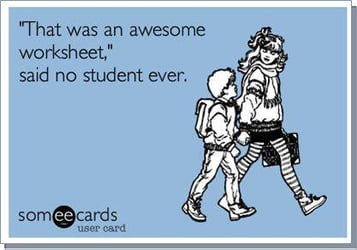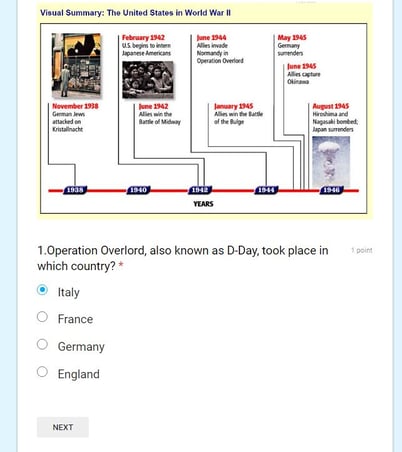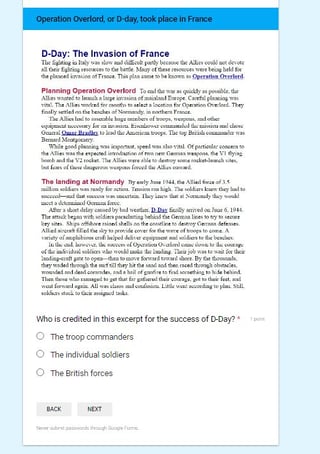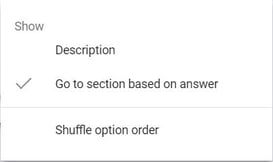by Miss Marisa Petraglia, Social Studies

Believe it or not, getting high school students excited to learn history is not always a walk in the park. (You mean to tell me you’re NOT pumped to dive into the intricate causes and effects of WWI?!) Add to that the obstacle of not having students physically in your presence in a cyber school setting and you need to do some fancy footwork to make sure students are staying engaged with their lessons. Through trial and error (AKA: a teacher's best friend) I have found some methods that promote student engagement in my classroom.
Google Forms
I use google forms in my class frequently. There are endless ways you can integrate google forms into your classroom. I love using them for pre-assessments, reteaching, attendance/exit slips, course feedback, and differentiating instruction. (Learn about more Google Education tools here)
Pre-assessment - Using forms set up as a quiz is a great way see where your students knowledge is currently and see what you need to cover more thoroughly. You can make any google form a quiz by clicking settings, make this a quiz. You can then create an answer key for each question and assign a point value. After the students take the quiz you can see what questions they are missing most that you will need to spend time on and what concepts they are already familiar with that don’t require as much attention.
Reteach- I use these as an extra credit opportunity for my students. After each test I send out a reteach form to the students. This gives the students an opportunity to earn some extra points and gives me the opportunity to ensure they understand the key concepts from the unit. In this form I use the add a new section and go to section based on answer features to reteach a concept that the student got wrong. For example if the student answers the following question wrong:

They are taken to the reteach section of that question where I insert a picture of the section from their book that discusses D-Day. They then need to answer another question about this section to ensure they read the material and now understand why they got the previous section wrong.

Here is a link to a few of my reteach forms as examples:
https://goo.gl/forms/fSXOFEkwccWJQTaD3
https://goo.gl/forms/rjinWvFm0XsKb3Tw1
Attendance/exit slips- Live learning class attendance in a cyber school can be tricky. Using frequent knowledge checks is one way to prevent the student from logging in and walking away. I also use attendance slips in the form of a google form to encourage active participation throughout my live lessons. I found myself taking several minutes in the beginning of class to take attendance on paper and then having to stop what I was doing during class when students logged in late. I have found a way to use forms to take care of all of these issues for me.
I send out two forms over the span of our live classes together. The first form is the attendance form, and the last form is the exit slip. Students have to fill out both forms in order to get full attendance for the day (if they miss the first form they are marked tardy, if they miss the last form they are marked as class cut). Using a form at the beginning of class that I paste into the chat box helps me keep track of attendance. Not only does this save me time, it also gives the students ownership in the classroom. I have the students write their names and then ask them a question as a warmup. The questions are all framed to get the students in the growth mindset way of thinking.
Below are some of the questions I ask students to answer:
- What is something you wish I knew?
- If you knew you couldn’t fail what would you do?
- What is something special about you?
- What does failure mean to you… Have you ever felt like a failure… How did you cope with failure?
- What is something you are unhappy about… Is this in your control… Yes: what is one step you can take to fix it in the short term, long term… No: how can you cope with it?
I also sometimes ask them silly questions to make them laugh or to get to know them better. I have found that they really take time and answer these questions seriously. They have told me that they look forward to the questions on the attendance forms every day because it makes them think.
I also use exit slips at the end of every class. I send them a link to the slip when we are finished with class work. They have to fill out the slip with their name and answer a question about the lesson that day. I have found that this keeps them more engaged in class since they know that they will have to answer a question about what they learned in order to get their attendance for that day. I also have found that more of them stay logged in until the end of class.
Course feedback- I ask my students for feedback frequently throughout the quarter. I like to get an idea of the things they enjoyed and did not enjoy and the things that helped them and the things they didn’t understand. I take their answers from the forms and apply the feedback in class. Who better to give me inside information on what is working and what isn’t than my students?
Differentiate instruction: Students can choose what they want to learn with a choose your own adventure activity. By using the go to page based on answer function (found in the menu section of each question) you can have students pick a topic and it will take them to text, links, pictures or video media on that subject.


You can then have them answer questions about that particular subject that interests them. You can click below for an example of this that I have used in my class. This was an enrichment activity used after we learned about the vietnam war.
https://goo.gl/forms/VgTgGPRmoadZcuex2
Interactive Presentations
One of my biggest struggles was how to get a large amount of information to my students during live class without just lecturing from a slide show. I have found two tools that have helped me exponentially with that: Nearpod and Peardeck. Both tools are similar in their delivery system.
You can make text slides and interactive slides to check for understanding during your lesson. I have gotten great feedback from students that they find it easier to understand the information when it is chunked into small pieces. They also likely find it easier because it keeps them more engaged during class. They are required to answer questions live in class, so they know they have to be paying attention. They retain more information this way.
It also gives me a chance to catch the concepts they are all struggling with in the moment and explain them in more detail. Both sites allow you to review reports after the session. You can see how each student interacted with the slides. Both sites have free accounts. Nearpod has a ton of interactive features that you can use in your classroom as well including virtual field trips. Nearpod also has the ability for students to complete sessions on their own asynchronously.
Interactive Videos
When giving a student a video to watch asynchronously how do you know that they really watched it? How do you know they didn’t just turn it on and walk away? The answer to both questions is you don’t. There are several tools you can use to combat this passive watching, I like Playposit. It is a free tool that allows you to upload videos and embed questions right in the video. You can also trim the video if there is a specific section you would like the students to focus on.

Jigsaw Work
I am a big fan of the Jigsaw approach. Students work together in small groups on one concept for a lesson, then they come together as a class and share what they learned. Students get the information of the whole lesson while working cooperatively with their peers.
One way I use this in the classroom is through collaborative google slides presentations. I make a google slides presentation before class starts by adding blank slides with titles with the different concepts that I want students to know. I share the presentation with the students, giving them editing rights (by clicking share and selecting from the drop down menu “Anyone with the link can edit”). I then assign groups of students each section to research and type their information into the slide.
At the end of class we all come together and review the google slide presentation together, just as I would if I had made the presentation myself. I will also add in any critical information they might have missed during their research that that time. The students have the presentation in their drive since it was shared with them so they can refer back to it when studying for their test in the future (hopefully). This keeps them engaged in class, and allows them to work collaboratively with their peers. You can also have them present their information to the class to add in a presentation/public speaking element to the lesson.
Wrapping Up
One question I have asked my students in the attendance form I send to them is this: “What is the greatest lesson you’ve learned about _______”. Sometimes I ask them the greatest lesson they’ve learned about life, sometimes it is school, sometimes it is studying or homework or something we are currently learning. I asked myself that question when I was preparing this blog post: What is the greatest lesson I’ve learned about engaging my students?
My answer is this: just try. Try something new. If it doesn’t work, it's not the end of the world. Worst case- doomsday scenario is that you lose one day of instruction. One day of instruction, while it sounds catastrophic to a teacher staring down all of the units they need to cover in a year sprinkled with standardized testing and other fun interruptions, is really okay. It’s okay because if it does work you might have a new tool that allows you to engage the students who typically don’t do their work or participate in class in a meaningful way. That is the goal: to reach all of our students. I am not under the illusion that I am going to get every student 100% engaged every time. I am, however, willing to try.



